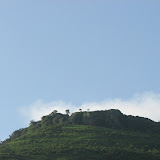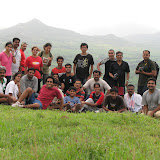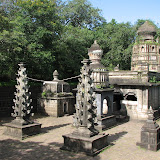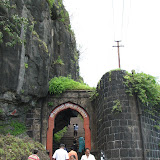Day 10, 17 Jun 08
To Dehradun & Mussoorie
5.00 am, I wondered if I’d been here for a vacation or a torture camp, every single day of this vacation I’d been up well before 5.00am. Today’s excuse, ‘Trip to Mussoorie’. We get ready by around 7.00 and cross Ram jhula. A Vikram’s ride leads us to the bus stand. The bus stand was nothing more than a empty ground, with rubbish in corner and a concrete post, where the officials handed over the tickets. We waited there for a Dehradun bus, which took about hour and half or so. All the bus lined up weren’t the ones required. Finally one with Dehradun showed up, a small mini bus. The crowd was bad and we somehow managed to get in. Vj and Mallik couldn’t make in the same bus but another standing by the side. Both these buses left at the same time though around 8 am! The route to Dehradun, the capital of Uttarakhand was good the highway cutting through forests. The roads were decent enough. I was standing most of the time later got a seat just to let off my weight off the legs.
Dehradun
9.30 am, We reached Dehradun, got down near a highway crossing. We had to take a vehicle for Mussoorie from the railyway station where the taxis and the bus stand stood. But before we could do all that.. we were HUNGRY. We headed into a sardarji’s dhaba and made ourselves comfortable in an odd half dhaba – half restaurant ambience. We pushed about more than 2 aloo parathas each. While eating we understood that those were half aloo half onion, WHY !? cause the kitchen had made it that way.. We didn’t care! parathaas.. aah! Some of us topped it with a sweet or salty lassi, guys weren’t sure if they got what they ordered. Anyways after the bill we headed towards station. At the station the taxi stands, etc were buzzing with the daily routine. Cab drivers eager to make every tourist his passenger, the careless bus drivers and ‘I care a shit’ attitude of the bus company employees.
After a few economical discussions on a cab-ride or bus ride, we decided on the later and … the crowded one. A Mussoorie bus, rumours came through the crowd that the bus was at the close by junction, and people started to run wildly towards the junction, as the bus approached the area, the conductor just refused to open the doors. We were halfway between running wildly and being civilized.. actually it didn’t really help. Somehow we managed to get into the bus. The bus left around 10 am and took another hour to reach the hills of Mussoorie.
Mussoorie
The ride to Mussoorie was just as wonderful as the name it self. Mussoorie overlooks the doon valley and is at the right top, a hill station ofcourse. The road leading to Mussoorie is a zig-zag winding one, all the way from the base to the town itself. It was raining lightly and the road was glittering. We reached at the Musoorie bus stop aroun 11.15. The bus stop, main bus stop of the town was just big enough to accomodate about 5-8 buses and had a small waiting room. It showed that Mussoorie was probably out of the range for the locals, but for just big industrialists and rich men which was evident from the extremely busy roads jammed with big cars honking in arrogance.
We decided to stroll along the Mall Road and enjoy the lovely climate. The rich and fashionable made their presence felt. Road cleanliness and town maintenance seemed to be the no. 1 priority of township government. There were trash bins all periodically, ad boards of keeping the hill town clean and beautiful. We made sure the lovely road just leaning over the edge overlooking the Doon valley was the place where we had ample of photos. Pressure is building inside my stomach ! The walk led us to the taxi stand where we hired a cab for Kempty water falls around 12.15 pm.
Kempty water falls are about 5-7 km down from Mussoorie, we arrived at the falls locked in a bad traffic jam. Our driver suggested that we move ahead on foot while he’d park the car. Even though being a Tue, a working day it was extremely crowded. All I could see were people. The Kempty water falls are lovely water falls in which the water actually flows over the huge rock faces, not the typical fall in which water comes off from a ridge. So its calm and beautiful. At the base there is an artifical catchment, which creates a pool like effect where people can enjoy. But that causes a lot crowd problems in that specific area. Its still raining. We climb some places for a better view of the falls, and all that leads to uncontrollable pressure. I ask Vj and Mallik to wait at a restaurant, while I can have a dump, I purchase a mineral water bottle! and search for a place/toilet/sulabh shauchaalay. But nothing is to be found, finally I find a place right underneath a hotel which is built on the edges and supported by coloumns wooden and concrete both. I knew this was the place. aaa aahh !! Phew ! I came back washed hands at the same restaurant where all were having their late-late breakfast. And then we headed towards the main fall, the rain has now started to come hard. So we wait near one of the restaurants near the fall, and we decide enough of this crowded nature. We’d seen more beautiful, incomparable vistas on our trek, this was just shit! So we decided to head back to the Cab and leave back for Mussoorie around 2.15pm.
At the Mussoorie bus stop we purchased tickets for Dehradun, and went to a shack for tea. We heard the bus roar behind us.. so we asked the guy…
भैय्या जलदी करना
to which another person responded in a jovial way..
अरे मसुरी आए हो आराम से खाओ पियो !! जलदी क्या है ?
हमारी बस छूत जाएगी…
he replied again..
अरे ऐसे कैसे छूटेगी !
In the bus we knew why that fellow person said so. I happened to be the bus conductor of our bus. As we climbed down the hills around 4.30, the Sun was getting low and producing even more beautiful images around us to lock into our minds and cameras both. Golden yellow clouds surrounded by beautiful blue-green sky.
We reached Dehradun ISBT around 6.30pm and hopped into the bus, when suddenly people frantically got up and went into another bus which left earlier than ours, however it left us with more seats to adjust with. The long journey scenic journey of Mussoorie had come to an end, we reached Hrishikesh around 8.30. Yet again crossed the Ram jhula in darkness, with only the smells and sounds of the hissing river beneath. On the road back to the Ashram around 9.00 we managed to have some typical north indian food, chhole, tandoori rotis and daal. Sleep wasn’t far away at 10.00pm




